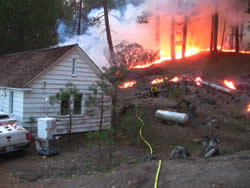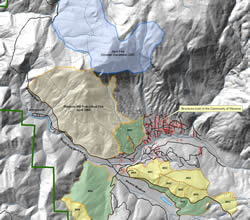Forests and Rangelands Success Story
Jack Fire Builds Upon Fuel Treatments to Protect Wawona
Yosemite National Park, California
National Fire Plan - Fuels Reduction
2008
The lightning-caused Jack Fire was detected on October 31, 2007. Located in the wilderness two miles north of the community of Wawona, the fire ignited near the top of Turner Ridge. For many years, Turner Ridge has posed a problem to fire managers at Yosemite. Despite its location in the wilderness, an absence of recent fire has made managing fire in this area difficult during the peak of fire season. A late season occurrence, as in this case, was ideal to tackle this complex fuels problem.
On the evening of November 7, the fire crossed Turner Ridge and began moving south, backing down towards the community of Wawona. Fire behavior was largely characterized by surface fire spreading in the deep litter with occasional torching accompanied by short-range spotting.
As the fire moved across Turner Ridge, protection of the community of Wawona was the priority, however, fire managers knew that reducing the fuels here would provide the best long-term protection for the community in the upcoming years. For this reason, the Jack Fire was managed on the north flank into the wilderness. The south flank, closest to the community of Wawona, was suppressed using the full array of suppression tools: fireline construction, contingency lines, aircraft support, and strengthening fuel breaks.
When the Jack Fire crested the ridgeline, it was highly visible from the community. Information and education within that community became a key component to the management of the fire. A series of public meetings were held in Wawona, keeping residents updated on fire response and giving them a chance to ask questions and share concerns. Through this dialogue, community input was incorporated into the fire response.
The Jack Fire was carefully managed until December 8, when a strong winter storm finally pushed through the Southern Sierra Nevada and extinguished the fire.
The benefits of the Jack Fire quickly became very clear, in terms of future community protection especially in relation to previous treatments in recent years - both prescribed fire and mechanical thinning - that have helped reduce the fuels that could feed an unwanted fire around the community of Wawona.
L. Dean Clark, recently retired from National Park Service fire, said, "Today’s fire management success is tomorrow’s opportunity." The sequence of burning around Wawona is a perfect example of that principle as prescribed fire, wildland fire, suppression, and mechanical thinning are represented. Each project creates an opportunity for the next. Yosemite National Park firefighters work each day to protect human communities by restoring healthy adjoining forest communities. Wilderness fire merged with a program of prescribed burning and fuel modification adjacent to communities enhances habitat, species diversity, and most importantly, community defensibility.
Contact: Adrienne Freeman, Gary Wuchner, (209) 372-0480.

